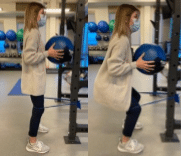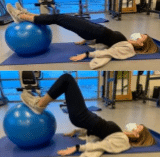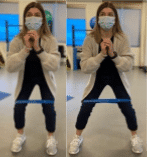Knee Pain Amongst Skiers
The current COVID-19 pandemic has made it increasingly challenging for people to find ways to stay active.
The health protocols and restrictions have resulted in an increase in outdoor activity with significant growth in the popularity of downhill skiing. While certain aspects of downhill skiing may promote components of health and wellness, the high speed nature of the sport means injuries, aches, and pains are very common amongst skiers resulting in a need for injury prevention. While equipment has evolved greatly over the years to ensure safety on the hill, knee injuries remain a common complaint amongst skiers accounting for an estimated 35% of all ski-related injuries.
These knee injuries range from simple to complex, and commonly include:
- MCL injuries
- ACL injuries
- Torn Meniscus
- Knee bursitis
- Patellar Tendinitis
- Patellar Dislocation
- Patellofemoral pain syndrome
The list above begs the questions: 1) What is causing these injuries? and 2) How can we prevent them from occurring and reoccurring?
Causes
While studies have shown that knee injuries are more common in women due to certain anatomical factors, such as narrower joint spaces and increased joint laxity, knee injuries are reported amongst all skiers. The causes of these injuries can be broken into the following categories: on-hill technique and equipment, and musculoskeletal factors.
Positioning On the Hill
Far too often, skiers position themselves by centering their weight behind them thereby forcing them into the “back seat” position (see figure 1). This position not only decreases control when descending the slope, but it additionally increases the likelihood of equipment failure and places undue stress on structures, in particular the knee. In addition to creating excess stress on the knee, this position further puts the skier in a vulnerable position by increasing the risk of catching the inside edge of their ski resulting in a great amount of force and torque being exerted on the knee. When skiers find themselves in this “back seat” position many will attempt to correct this by forcefully contracting their quadriceps muscle as a way of shifting their weight
Figure 1. “back seat” skiing refers to positioning the body in a way that places the majority of the skier’s body weight behind.
Figure 2. Proper skiing technique includes centering your weight over your base of support and keeping forward pressure through the front of the boots.
forward. This aggressive contraction has been seen to produce excessive forwards propulsion once again placing undue stress of the structures around the knee. This then emphasizes the importance of avoiding this “back seat” position (see figure 2) by strengthening the areas to best support proper form.


It Takes Strength!
While correct technique effectively reduces the chance of injury, conditioning is widely recommended to allow for the execution of proper technique and prevent injury. The muscle groups that are most important in terms of knee injury prevention include the quadriceps, hamstrings, and gluteal muscle groups. Although at first glance, the quadriceps and hamstrings seem to intuitively support the knee, gluteal strength is not to be overlooked.
Adequate gluteal strength is vital in the prevention of knee injuries as it has been shown to play a large role in stabilizing the knee and supporting efficient movement patterns. When it comes to determining the best strengthening exercises, the research currently points to the importance of eccentric contractions (otherwise known as the lengthening phase of the muscle) as a way of maximizing strength gains and preventing injury.
The accelerated forces combined with the sharp turns seen in downhill skiing consequently result in eccentric contractions being a predominant muscle contraction justifying their importance in strength programs. Figures 3,4,5 illustrates 3 exercises that target eccentric contractions for the muscle groups discussed. While developing adequate muscular strength is a crucial part of knee injury rehabilitation and injury prevention, maintaining mobility and incorporating balance exercises has been found to further support the reduction of injury incidence and severity.

Figure 3. Eccentric squats
Begin this exercise by securing a theraband just above your knees. When performing this exercise, slowly lower for a count of 6 seconds from a standing position into a squat by driving your hips behind you. Return to a standing and repeat for 5-10 repetitions within your tolerance. To make this more difficult, hold a medicine ball or weight in your arms.</>

Figure 4. Eccentric Hamstring curls
When performing this exercise start in position A. Contract your gluteal muscles and abdominals to maintain balance while using your heels to roll the ball towards you. Slowly return for a count of 6 seconds to position A. Repeat this for 5-10 repetitions within your tolerance.</>

Figure 5. Lateral Walks
Begin this exercise by securing a theraband just above your knees. When performing this exercise, start by lowering into a squat by driving your hips behind you. Hold this position while taking small steps to the side and maintaining tension on the band. Take 5-10 in one direction before switching to the other direction. To make this more difficult, lower the theraband to your ankles.</>
What Physiotherapy Can Do For You
Physiotherapists are specialists in pain management, assessing muscular strength, and identifying areas of weakness and decreased mobility. Consulting a physiotherapist to assess your knee pain will allow you to better understand your injury and allow you to gain knowledge on the proper injury management and rehabilitation interventions needed to effectively rehab your specific injury. At Advantage Sports Medicine Physiotherapy, we use hands-on manual therapy to help promote recovery and healing and provide you with the necessary tools to take control of your rehabilitation journey and get back to having fun on the hill!
References
Barton, C. J., Lack, S., Malliaras, P., & Morrissey, D. (2012). Gluteal muscle activity and patellofemoral pain syndrome: A systematic review. British Journal of Sports Medicine, 47(4), 207-214. doi:10.1136/bjsports-2012-090953
Buckthorpe, M., Stride, M., & Villa, F. D. (2019). ASSESSING AND TREATING GLUTEUS MAXIMUS WEAKNESS – A CLINICAL COMMENTARY. International journal of sports physical therapy, 14(4), 655–669.
Barton, C. J., Lack, S., Malliaras, P., & Morrissey, D. (2012). Gluteal muscle activity and patellofemoral pain syndrome: A systematic review. British Journal of Sports Medicine, 47(4), 207-214. doi:10.1136/bjsports-2012-090953
Burtscher M, Federolf PA, Nachbauer W, Kopp M. Potential Health Benefits From Downhill Skiing. Front Physiol. 2019 Jan 14;9:1924. doi: 10.3389/fphys.2018.01924. PMID: 30692936; PMCID: PMC6340074.
Coppack, R. J., Etherington, J., & Wills, A. K. (2011). The Effects of Exercise for the Prevention of Overuse Anterior Knee Pain: A Randomized Controlled Trial. The American Journal of Sports Medicine, 39(5), 940–948. https://doi.org/10.1177/0363546510393269
Davey, A., Endres, N. K., Johnson, R. J., & Shealy, J. E. (2019). Alpine Skiing Injuries. Sports health, 11(1), 18–26. https://doi.org/10.1177/1941738118813051
Davidson, T. M., & Laliotis, A. T. (1996). Alpine skiing injuries. A nine-year study. The Western journal of medicine, 164(4), 310–314.
Deady LH, Salonen D. Skiing and snowboarding injuries: a review with a focus on mechanism of injury. Radiol Clin North Am. 2010 Nov;48(6):1113-24. doi: 10.1016/j.rcl.2010.07.005. PMID: 21094401.
Graepel, S. (2017, December 14). Avoid Knee Injuries While Skiing: Tips to Keep You Healthy. Retrieved January 10, 2021, from https://gearjunkie.com/how-to-avoid-knee-injuries-while-skiing-tips
Franklin, J. (2017, February 09). Knee Pain and Skiing. Retrieved January 11, 2021, from https://orthopedicspecialistsofseattle.com/healthcare/injuries/knee-pain-skiing/
Hébert-Losier, K., Holmberg, HC. What are the Exercise-Based Injury Prevention Recommendations for Recreational Alpine Skiing and Snowboarding?. Sports Med 43, 355–366 (2013). https://doi.org/10.1007/s40279-013-0032-2
Hunter RE. Skiing injuries. Am J Sports Med. 1999 May-Jun;27(3):381-9. doi: 10.1177/03635465990270032101. PMID: 10352778.
Johnson, R. J., Ettlinger, C. F., & Shealy, J. E. (2009). Myths Concerning Alpine Skiing Injuries. Sports Health, 1(6), 4
Koehle, M.S., Lloyd-Smith, R. & Taunton, J.E. Alpine Ski Injuries and Their Prevention. Sports Med 32, 785–793 (2002). https://doi.org/10.2165/00007256-200232120-00003
Macdonald, L. (2013). How to avoid knee pain when skiing. Retrieved January 10, 2021, from https://www.coachmag.co.uk/exercises/sport-workouts/2183/how-avoid-knee-pain-when-skiing
Prlić, J., Grle, M., Moro, G. i Grle, I. (2019). Balance as a Risk Factor for Injury Occurrence in Recreative Skiing. Collegium antropologicum, 43 (2), 103-110. Preuzeto s https://hrcak.srce.hr/225662
Shea, K. G., Archibald-Seiffer, N., Murdock, E., Grimm, N. L., Jacobs, J. C., Jr, Willick, S., & Van Houten, H. (2014). Knee Injuries in Downhill Skiers: A 6-Year Survey Study. Orthopaedic journal of sports medicine, 2(1), 2325967113519741. https://doi.org/10.1177/2325967113519741
Turner, S. (2019). 4 Tips to Avoid Knee Injuries While Skiing. Retrieved January 10, 2021, from https://www.sports-health.com/blog/tips-avoid-knee-injuries-while-skiing</>
